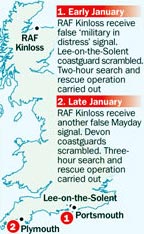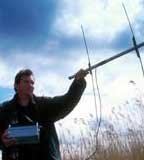Wednesday 15 February, 2006, 13:26 - Radio Randomness
 I read an article in The Times newspaper yesterday entitled 'Coastguard scrambled as set-top box sends SOS'. It would appear that, on two separate occasions, radio emissions from a Freeview set-top box had raised an alert with the coastguard who had sent search and rescue helicopters out to find the source, apparently costing GBP20,000 or so on each occasion (special 'centrifrugal' helicopter fuel is very expensive you see).
I read an article in The Times newspaper yesterday entitled 'Coastguard scrambled as set-top box sends SOS'. It would appear that, on two separate occasions, radio emissions from a Freeview set-top box had raised an alert with the coastguard who had sent search and rescue helicopters out to find the source, apparently costing GBP20,000 or so on each occasion (special 'centrifrugal' helicopter fuel is very expensive you see).The alert concerned was simply a transmission on a frequency of 121.5 MHz, one of the internationally recognised distress frequencies. Devices called Emergency Position-Indicating Rescue Beacons (EPIRBs) use this, and other frequencies (406.1 MHz for civil and 243.0 MHz for military emergencies) to alert an international network of Search and Rescue satellites (SAR-SATs) when a vessel is in distress. The various satellites which monitor this frequency can pin-point to within an accuracy of about 20km, the location of any transmission, over an area comprising about 60% of the surface of the earth. The unintentional radiation from the set-top box would therefore have triggered the satellites (which believed it was a distress beacon) to alert ground stations to the signal. The fact that the set-top box concerned was located in Plymouth, a busy naval town as opposed to in the middle of the English countryside would have further alarmed the coastguard (as boats in distress surrounded by miles of farmland would be rather suspicious).
 The story continues to say that officials tracked down the source of the interference and knocked, antennas in hand, on the door of the poor unsuspecting lady whose box was at fault. She clearly thought she had been tracked down for television licence evasion, though why she would think this if she had a licence is rather confusing. Obviously the signals were strong enough to merit intervention from the authorities, who took the action of tracking and closing down the problem rather than allowing it to continue.
The story continues to say that officials tracked down the source of the interference and knocked, antennas in hand, on the door of the poor unsuspecting lady whose box was at fault. She clearly thought she had been tracked down for television licence evasion, though why she would think this if she had a licence is rather confusing. Obviously the signals were strong enough to merit intervention from the authorities, who took the action of tracking and closing down the problem rather than allowing it to continue.Two things are surprising about this story. Firstly, the fact that the transmissions from the set-top box were strong enough to raise the alert with the satellite network. EPIRBs operating on 121.5 MHz typically use a power of 50mW or more. The malfunction of the set-top box must have caused some device within the box to oscillate and these oscillations were then radiated back through the TV antenna or the down-lead. To get a 50mW signal in such circumstances, however, is pretty good going. Even a well designed VHF oscillator would struggle to provide a stable 50mW of power on a fixed frequency without drifting as the oscillator got warmer or cooler. And given the poor performance of the antenna at these frequencies, it is likely that the power generated by the set-top box would need to be significantly more than this. It is no surprise that a ground-based search was also able to track down the signal!
 It is worrying in many ways that this is the case. Had the transmission been on a different frequency (for example 121.9 MHz) it would have interfered with air-traffic control (in this case at Heathrow airport). Such events do regularly occur, however there are no satellites that can pin-point the location of the transmission and many go unchecked.
It is worrying in many ways that this is the case. Had the transmission been on a different frequency (for example 121.9 MHz) it would have interfered with air-traffic control (in this case at Heathrow airport). Such events do regularly occur, however there are no satellites that can pin-point the location of the transmission and many go unchecked. The second thing which is surprising is that the box could produce such radiations in the first place. All electronic equipment has to conform to a set of standards known (in Europe) as the EMC directive. This requires all manufacturers to certify that their equipment does not suffer when in the presence of nearby radio transmissions AND that it does not cause unintentional radiation. The set-top box would have had to conform to this standard and thus should have been checked for emissions. Clearly, in this case, the set-top box was malfunctioning, which means that the tests conducted by manufacturers are not extensive enough to capture the results of fault conditions. Does that mean that I could produce a toaster which, if held upside down radiated a couple of Watts in the FM band and claim it conformed when used normally, to toast bread?
What's most worrying is that there are probably hundreds more cases of such radiation which go on unnoticed. In one respect the fact that they are unnoticed means that they are not causing anyone any problems. On the other, it does question whether opening up the use of the radio spectrum in a less controlled manner would really cause the mass devastation that many people seem to think it would.
add comment
( 1166 views )
| permalink
| 



 ( 2.8 / 1821 )
( 2.8 / 1821 )




 ( 2.8 / 1821 )
( 2.8 / 1821 )

